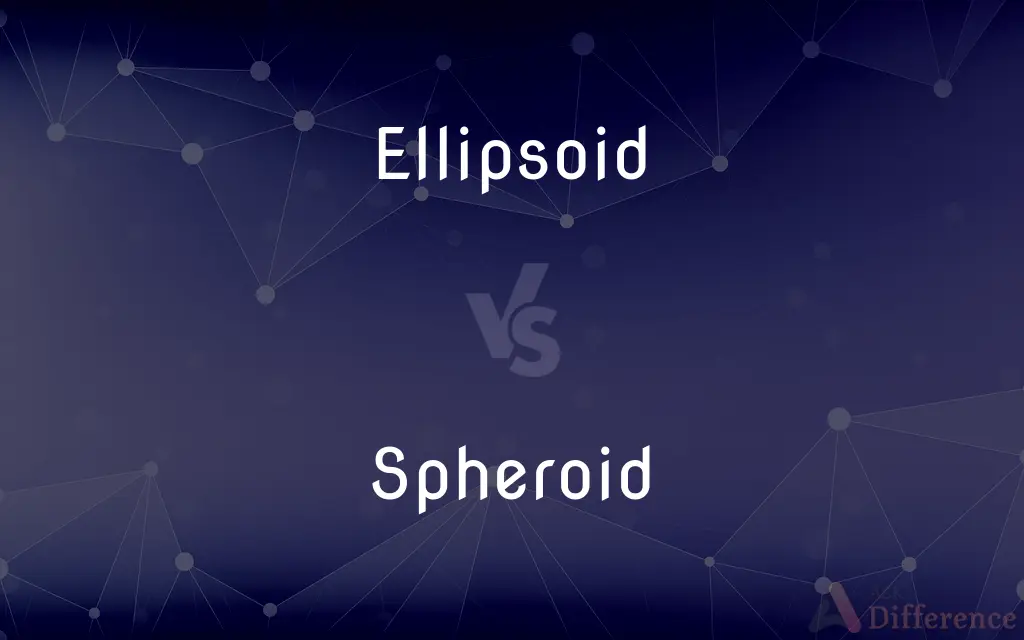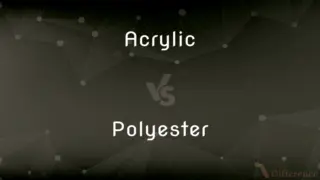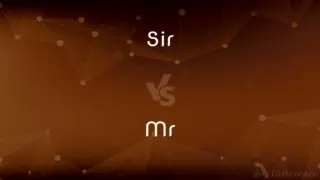Ellipsoid vs. Spheroid — What's the Difference?
By Fiza Rafique & Maham Liaqat — Updated on March 26, 2024
An ellipsoid extends in three dimensions with three distinct axes; a spheroid is an ellipsoid of revolution with two identical axes.

Difference Between Ellipsoid and Spheroid
Table of Contents
ADVERTISEMENT
Key Differences
An ellipsoid is a surface that in three-dimensional space extends along three axes, which are of different lengths, giving it a more stretched or flattened shape. While a spheroid, a type of ellipsoid, is specifically symmetrical about two of its three axes, resulting in a shape that is either elongated or flattened but revolves around a single axis.
Ellipsoids are defined by their three semi-principal axes, which are all of different lengths, providing a broad range of shapes from oblate to prolate forms. On the other hand, spheroids have two axes of the same length, distinguishing them as either oblate (flattened at the poles) or prolate (stretched along one axis), based on their symmetry about the rotational axis.
The applications of ellipsoids and spheroids differ due to their geometric properties. Ellipsoids are often used in fields requiring general three-dimensional modeling, such as in geodesy for representing the Earth's shape in a more accurate way. Spheroids, however, are commonly used in simpler models of the Earth and celestial bodies, where the symmetry simplifies calculations and visualizations.
Both ellipsoids and spheroids play critical roles in astrophysics and planetary science for modeling the shapes of planets and stars. However, the choice between using an ellipsoid or spheroid model depends on the level of precision required and the specific characteristics of the body being modeled.
Comparison Chart
Axes
Three distinct lengths
Two of the same length, one distinct
ADVERTISEMENT
Symmetry
No specific symmetry
Symmetrical about two axes
Shape Variation
Broad range, from stretched to flattened
Limited to oblate and prolate forms
Applications
General 3D modeling, geodesy
Earth and celestial bodies modeling
Compare with Definitions
Ellipsoid
A geometric surface all of whose plane sections are ellipses or circles.
The ellipsoid has been used in physics to model the shape of the earth.
Spheroid
In physics and astronomy, a model used for celestial bodies that are not perfect spheres.
Spheroid models are essential for understanding the Earth’s geoid shape.
Ellipsoid
An object whose shape is reminiscent of an elongated or flattened sphere.
Some fruits and vegetables naturally take on an ellipsoidal shape.
Spheroid
A geometric shape that is almost spherical but slightly compressed or stretched along one axis.
Many planets and moons can be approximated as spheroids due to their rotation.
Ellipsoid
A three-dimensional figure extended along three axes of different lengths.
An egg shape can be approximated by an ellipsoid model.
Spheroid
A term used to describe the shape of oblate or prolate ellipsoids of revolution.
Spheroids have applications in both theoretical and applied sciences.
Ellipsoid
A term used in geometry to describe a surface whose planar cross-sections are all ellipses.
Ellipsoids are studied in advanced mathematics due to their unique properties.
Spheroid
A special case of an ellipsoid with two equal semi-diameters.
The Earth is often modeled as a spheroid to simplify calculations.
Ellipsoid
An ellipsoid is a surface that may be obtained from a sphere by deforming it by means of directional scalings, or more generally, of an affine transformation. An ellipsoid is a quadric surface; that is, a surface that may be defined as the zero set of a polynomial of degree two in three variables.
Spheroid
An ellipsoid of revolution formed by rotating an ellipse about one of its principal axes.
A spheroid can result from spinning an ellipse around its major or minor axis.
Ellipsoid
A geometric surface, all of whose plane sections are either ellipses or circles.
Spheroid
A spheroid, also known as ellipsoid of revolution or rotational ellipsoid, is a quadric surface obtained by rotating an ellipse about one of its principal axes; in other words, an ellipsoid with two equal semi-diameters. A spheroid has circular symmetry.
Ellipsoid
A surface, all of whose cross sections are elliptic or circular (including the sphere), that generalises the ellipse and in Cartesian coordinates (x, y, z) is a quadric with equation x2/a2 + y2/b2 + z2/c2 = 1. Category:en:Surfaces
Spheroid
A body that is shaped like a sphere but is not perfectly round, especially an ellipsoid that is generated by revolving an ellipse around one of its axes.
Ellipsoid
(geography) Such a surface used as a model of the shape of the earth.
Here the geoid is thirty meters below the ellipsoid.
Spheroid
Of a shape similar to a squashed sphere.
Ellipsoid
Shaped like an ellipse; elliptical.
Spheroid
A solid of revolution generated by rotating an ellipse about its major (prolate), or minor (oblate) axis.
UFOs are reported as being either oblate (saucer-shaped) or prolate (cigar-shaped) spheroids.
Ellipsoid
(mathematics) Of or pertaining to an ellipse; elliptic.
Spheroid
A body or figure approaching to a sphere, but not perfectly spherical; esp., a solid generated by the revolution of an ellipse about one of its axes.
Ellipsoid
(botany) Having the tridimensional shape of an ellipse rotated on its long axis.
Spheroid
A shape that is generated by rotating an ellipse around one of its axes;
It looked like a sphere but on closer examination I saw it was really a spheroid
Ellipsoid
Pertaining to, or shaped like, an ellipsoid; as, ellipsoid or ellipsoidal form.
Ellipsoid
A surface whose plane sections are all ellipses or circles;
The Earth is an ellipsoid
Ellipsoid
In the form of an ellipse
Common Curiosities
How do ellipsoids and spheroids differ in symmetry?
Ellipsoids have no specific symmetry, while spheroids are symmetrical about two of their three axes.
What is an ellipsoid?
An ellipsoid is a three-dimensional shape with each of its three axes of different lengths.
What is a spheroid?
A spheroid is a type of ellipsoid symmetrical about two axes, forming a shape close to a sphere but elongated or flattened along one axis.
How are ellipsoids used in real-world applications?
Ellipsoids are used in geodesy, physics, and 3D modeling to represent the Earth and other celestial bodies.
Can a spheroid be considered a special case of an ellipsoid?
Yes, a spheroid is a special case of an ellipsoid with two of its axes being of equal length.
What makes a spheroid different from a perfect sphere?
Unlike a perfect sphere, a spheroid is slightly compressed or elongated along one axis.
How do the shapes of ellipsoids vary?
Ellipsoids can vary widely in shape, from nearly spherical to significantly elongated or flattened forms.
Why are spheroids important in astronomy and geodesy?
Spheroids simplify the mathematical modeling of Earth and celestial bodies, balancing accuracy with computational simplicity.
How do spheroids help in understanding the universe?
Spheroids provide a simplified model for celestial bodies, aiding in the study of their dynamics, structure, and evolution.
What is the significance of the rotational symmetry in spheroids?
The rotational symmetry in spheroids simplifies the mathematical modeling of objects like planets, making them easier to study and visualize.
What are oblate and prolate spheroids?
Oblate spheroids are flattened at the poles and bulge at the equator, whereas prolate spheroids are elongated along one axis.
Are all ellipsoids asymmetrical?
Not necessarily. While ellipsoids generally have three axes of different lengths, their symmetry depends on the context and definition being used.
Can the Earth be accurately described as a spheroid?
Yes, the Earth can be accurately described as an oblate spheroid due to its equatorial bulge caused by rotation.
Share Your Discovery

Previous Comparison
Acrylic vs. Polyester
Next Comparison
Sir vs. MrAuthor Spotlight
Written by
Fiza RafiqueFiza Rafique is a skilled content writer at AskDifference.com, where she meticulously refines and enhances written pieces. Drawing from her vast editorial expertise, Fiza ensures clarity, accuracy, and precision in every article. Passionate about language, she continually seeks to elevate the quality of content for readers worldwide.
Co-written by
Maham Liaqat















































